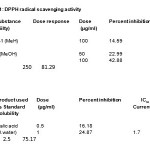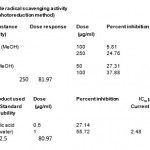Manuscript accepted on : May 19, 2008
Published online on: 11-03-2016
K. Ravishankar1*, K .V. R. N. S. Ramesh1 and B. Ganga Rao2
1Aditya Institute of Pharmaceutical Sciences and Research, Surampalem India.
2University college of Pharmaceutical Sciences, Andhra University, Visakhapatnam India.
ABSTRACT: The antioxidant activity of Andrographis serpyllifolia and Gymnema sylvestre root extracts were investigated by the DPPH and NBT Riboflaving photoreduction methods. The root extract of Gymnema sylvestre showed promising free radical scavenging activity. A maximum percentage inhibition of 81.29 was observed with Gymnema sylvestre root extract. There is found to be a linear relationship between the dose and the antioxidant activity which could be expressed in the form of an equation y=0.2834n+11.272.
KEYWORDS:
Antioxidant activity; Gymnema sylevestre; Andrographis serpyllifolia; DPPH; Super oxide
Download this article as:| Copy the following to cite this article: Ravishankar K, Ramesh K. V. R. N. S, Rao B. G. Comparitive Study of Antioxidant Activity of Root Extracts of Andrographis Serpyllifolia and Gymnema Sylvestre. Biosci Biotechnol Res Asia 2008;5(1) |
| Copy the following to cite this URL: Ravishankar K, Ramesh K. V. R. N. S, Rao B. G. Comparitive Study of Antioxidant Activity of Root Extracts of Andrographis Serpyllifolia and Gymnema Sylvestre. Biosci Biotechnol Res Asia 2008;5(1). Available from: https://www.biotech-asia.org/?p=7096 |
Introduction
The role of free radicals and reactive oxygen species (ROS) in the pathogenesis of human diseases such as cancer, aging, inflammatory response syndrome, respiratory diseases and liver diseases is widely recognized¹. Electron acceptors such as molecular oxygen readily react with free radicals to become free radicals themselves. Prominent manifestation of free radical activity in biological systems is lipid peroxidation and it is involved in the development of different diseases².Research is focused on the use of anti-oxidants with particular emphasis on naturally derived anti-oxidants which inhibit ROS production and display protective effects. Plant phenolics, for example, Phenolic acids3,4, Tannins5,6 and flavonoids7 are known to be potent anti-oxidants and occur in vegetables, fruits, seeds and barks. It is suggested there is an inverse relationship between dietary intake of anti-oxidant rich food and the incidence of human disease. Therefore the research for the determination of natural antioxidant source is important8-14.
Dpph radical scavenging activity
DPPH (1,1-diphenyl-2picryl-hydrazyl) free radical scavenging activity of the test compounds was determined by the method of Lamaison et. al15., which depends on scavenging of coloured free radical (DPPH) in methanol solution by the test drugs. The reaction mixture contains DPPD and test drug in a final volume of 3 mL. Gallic acid was taken as reference standard. The concentrations of test extract and the reference employed are shown in Table and Fig.1.Absorption of DPPH at it’s adsorption maximum 516nm is inversely proportional to the concentration of the scavenger (Test drug). The activity was expressed as inhibitory concentration 50 (IC50) i.e. the concentration of the test solution required to give 50% reduction in absorbance of the test solution as compared to that of blank solution. The results are expressed in Table and Fig. 1.
 |
Figure 1: DPPH radical scavenging activity.
|
Material and Methods
Plant material extraction
Gymnema sylvestre plant root was collected Tanjavur (India). The root was dried under shade and powdered in a mechanical grinder.
The root powder was extracted with 70% ethanol by cold maceration. The extraction was done for 72 hours. After extraction the extract was separated from marc by filtration through filter paper. The marc was pressed with muslin cloth to remove the solvent which is left in the marc after filtration.
The filtrate was preserved in a well closed container. The marc left after extraction was further extracted by cold maceration with the same solvent. And the process was repeated one more time.
That is the drug was extracted with a gap of 3 days each.
a, a–diphenyl-b-picryl hydrazyl, galic acid were obtained from Sigma Chemical Co. (St.Louis, MO, U.S.A.) All other the chemicals used are of analytical grade and the solvents used for extraction are from Ranbaxy fine chemicals, New Delhi.
The UV Visible spectrophotometric values
were recorded employing Varian-Cary-50
UV Spectrophotometer.
Superoxide radical scavenging activity
Method: Nbt / riboflavin photoreduction (mccord and fridovich)
The superoxide free radical scavenging activity of the test extracts is determined by the method of Mccord and Fridovich which depends on light induced super oxide generation by riboflavin and the corresponding reaction of vitro blue tetrazolium (NBT).
The assay mixture contained different concentrations of test extracts and EDTA (6 mm containing 3 mg of NaCN), NBT (50 mm), riboflafin (2 mm) and phosphate buffer (58 mm, pH 7.8) to give a total volume of 3 ml. The tubes are uniform by illuminated for 15 min, and there after the absorbances are measured at 560 nm.
The percentages inhibition by the test drug of super oxide production was evaluated by comparing the absorbance values of standard and experimental tubes. Gallic acid in distilled water at different concentrations is used as standard for comparison. Table and Fig. 2 (Given below).
 |
Figure 2: Superoxide radical scavenging activity.
|
Results and Discussion
The extracts showed promising free radical scavenging activity and also super oxide radical scavenging activity. In between Andrographis serpyllifolia root extract and Gymnema sylvestre root extract, Gymnema sylvestre showed much higher activity with Andrographis serpyllifolia root extract showing little scavenging activity nature. A maximum percentage inhibition of 81.29 was observed with Gymnema sylvestre root extract at dose of 250 µg/ml. The IC50 µg/ml for Gymnema sylvestre root extract is found to be 136.6, where as for Andrographis serpyllifolia root extract even at a concentration of more than 100 µg/ml. the percentage inhibition is found to be 14.59. only. In case of Gymnema sylvestre root extract not only a good inhibition but also there is found to be a linear response with increasing dose (Table and Fig. 1). The dose vs. response relationship could be expressed in the form of equation y=02834 n +11.272. A good correlation coefficient (R2= 0.9901) indicated a good linear relationship.
References
- B. Halliwell and J. Guttridge, Free radicals in biology and medicine, (Japan Scientific Press, Tokyo) (1989).
- Pratt DE. And Hudson BJF. Natural antioxidants not exploited commercially In: Hudson, BJF, eds. Food Antioxidants. 1sted Amsterdam: Elsevier; 171-192 (1990).
- M. Raquel and B. Laura. Chromatographic and electrophoretic methods for the analysis of biomarkers of ixidative damage to macromolecules (DNA, lipids, and proteins). J. Sep. Sci. 30: 175-91 (2007).
- D. Grotto, M.L.D. Santa, S. Boeira, J. Valentini, M.F. Charao, A.M. Moroa, P.C. Nascimento, V.J. Pomblume and S.C. Garcia. Rapid quantification of malondialdehyde in plasma by high performance liquid chromatography-visible detection. Journal of Pharmaceutical and Biomedical Analysis. 43: 619-24 (2007).
- P. Jurgen, M. Ingolf and H.G. Christoph. Measurement of free and bound malondialdehyde in plasma by high-performance liquid chromatography as the 2,4-dinitrophenylhydrazine derivative. Journal of Chromatography B. 742: 315-25 (2000).
- T.C. dinis, C.L. Santosa and L.M. Almeida. The Apoprotein is the preferential Target for Deoxynitrite induced LDL damage protection by Phenolic acids. Free Radical Res. 36(2): 531-43 (2002).
- T. Ogiwara, K. Satoh, T. Negoro, H. Okayasu, H. Sakagami and S. Fujisawa. Inhibiton of NO production by activated macrophages by phenol carboxylic acid monomers and polymers and radicals scavenging activity,. Anticancer Res. 23(2B): 1317 (2003).
- L. Zang, G. Cosma, H. Gardner, V. Castranova and V. Vallyathan. Effect of chlorogenic acid on hydroxyl radical. Mol. Cell Biochem. 247(12): 205-10 (2003).
- Ali Y., Munir O. and Vinit B.,. The antioxidant activity of the leaves of Cydonia vulgaris, turk J.Med. Sci., 31: 23-27 (2001).
- Evans W.C., Trease and Evan’s Pharmacognosy, 15th edn, W.B. Saunders Company, 35 (1996).
- Kirtikar K.R.and Basu B .D., Indian Medicinal Plants Part – III, 2nd edn, International Book Distributors, 68 (1995).
- Chopra R.N., Nayar S.L. and Chopra, I.C., Glossary of Indian Medicinal Plants, Publications and Information directorate, CSIR, 240 (1992).
- Nadkarni K.M: Indian Materia Medica, Edn 3, Vol I, Popular Prakashan Private Ltd, Bombay, 1017 (1995).
- Fridovich I : Biological effects of superoxide radical,Archives of Biochemistry and Biophysics, 247: 1-11 (1986).
- Lamaisan, J.L. and A. Carnet., Jeneurs en princepaux flavonads desfleurs de crataegius monogyna jacq et de crataegius laevigata (Poiret D.C) en function dela regetation. Pharma Acta Helv., 65: 315-320 (1990).

This work is licensed under a Creative Commons Attribution 4.0 International License.





